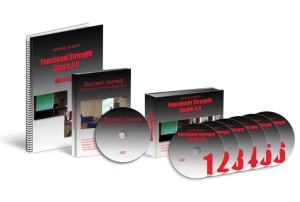You know what I’ve learned after talking to incredible sports physiotherapists and sports medicine professionals, attending numerous professional development courses, conferences and seminars and reading many books: there is so much that I don’t know. And I say that without reservation, as I know that it is impossible to stay at the forefront of current practice and research in all fields of sports medicine. There is just not enough hours in the day. Fortunately, I also know not to pass up opportunities to learn from experts in a given field. Thus, I would like to introduce you to Michael Boyle.
Something A Little Different: So, I have decided to do something a little bit different. I have invested some time into creating some videos for YouTube based on various diagnoses and pathologies that have been previously discussed on this site. I have done this for a few reasons, including to allow the blog/site to reach a greater audience, to assist or cater for those who prefer to watch or listen to information rather than read lengthy articles and also to allow physiotherapists and physical therapists to refer patients/athletes to the videos as a source of information, which can be consumed in their own time….
If you work with athletes who train hard, as many sports physiotherapists do, then you will have encountered exercise induced muscle damage or delayed onset muscle soreness (DOMS). It is also likely that the suffering athlete has come to you and said “I’m so sore from that workout – can you do anything?”. There are many widely used post workout and recovery strategies that are touted as effective at enhancing an athletes recovery from high intensity exercise. However, as is frequently the norm in sports medicine, the evidence for their use is mostly anecdotal rather than based on high quality clinical trials. Fortunately, a new review recently published discusses the effectiveness of physiotherapeutic interventions following high intensity exercise.
As sports physiotherapists we readily prescribe exercise programs to our athletes/patients – quite simply – it is a massive part of what we do. As well as exercises, we also tell our patients what they should NOT be doing – “You should not do this OR that”! Have you ever wondered how much they really take our advice? Unfortunately (for both us and the patient) our patients are frequently non-compliant with our rehabilitation programs.So here are some evidence based tips to improve patient compliance!
Neck pain is a common clinical presentation, affecting up to two-thirds of the population at some time in their life. Therefore, as sports physiotherapists we will regularly assess and treat athletes with recent onset neck pain. As a component of rehabilitation many physiotherapists will include some form of evidence based manual therapy, commonly either mobilisation or manipulation. However, a clinical question I am often asked (by both myself and patients) is what additional benefits does manipulation provide, given the additional risks? This clinical question is answered by a recent RCT that compares the use of mobilisation and manipulation in patients with recent onset neck pain.
In the retail and customer service world, we are told, the customer is always right. Whilst you may think that this has no relevance to the world of sports physiotherapy, where the athletes or patient are frequently wrong, it is surprising how frequently the athletes beliefs can affect your (yes, you!) clinical reasoning or practice. In this article I discuss how patients may dictate your treatments, and identify some of the issues with allowing this to happen.
You might ask why I am bothering to tell you, the avid and good looking sport physiotherapist, what plans we have the website in 2011. Well, I have decided to let you know for two main reasons. The first is because it will affect you guys. 2010 was OK, but 2011 will be awesome! I will expand below. The second reason is that by putting it out there, it serves as a good motivational tool. Plus, you guys can keep me in line. In this post, I will discuss the big goals for the site in 2011.
Patients say the darndest things, they really do. On an almost daily basis I have to stop myself from laughing at some of the things that they tell me, that are not meant to be funny. Whilst it is clearly inappropriate to laugh at them, and I never ever recommend this, I thought I would write this post as a light hearted look at some patient interactions. Below I discuss my 4 favourite statements that patients said to me this week.
I know what you are thinking, I really do. How can a lack of knowledge EVER make you a better physiotherapist? You are thinking it can’t! Well, you are probably right. Probably. But I feel that there are some times that not knowing something, a diagnosis, the best interventions, the current research, whatever, can make you a better sports physiotherapist in the eyes of your athlete.
As sports physiotherapists we assess, diagnose and rehabilitate a broad range of musculoskeletal conditions. Obviously we all see a myriad of conditions which are quite easy to diagnose and are quick to rehabilitate. This is the ideal situation for both the athlete and physiotherapist as the return to play timeframes are short. However, as we are all acutely aware, all sports injuries do not fit this category. In this article I discuss my three most hated sports injury diagnoses, in ascending order of hatred (yes – hatred).
In the past this site has featured some lighter, colloquial blog posts. These articles discuss issues related to the greater physiotherapy community. Thus, I present a few mantras I have heard, adapted or made up for the physios to live by in the coming year.
Radial tunnel syndrome is rare, it is challenging to differentially diagnose and can be a monster to manage. If you have a recalcitrant case of tennis elbow then this post will interest you! This article discusses the best available evidence for assessment and management of radial tunnel syndrome.










